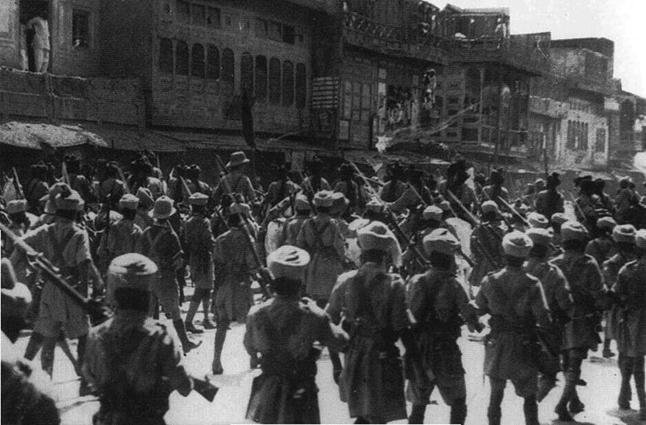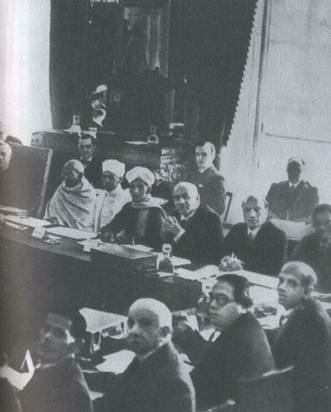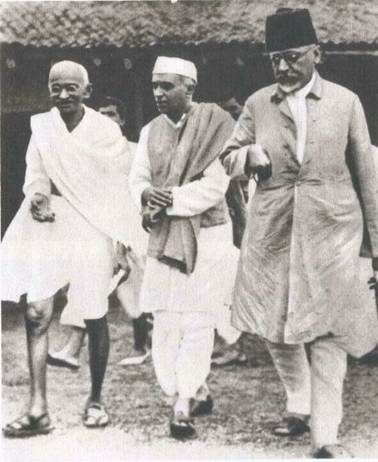|
Sarvadayya
|
Satyahraha
|
|
- return to sources, the "golden age" when Indians lived in harmony with nature as dominated peasant community, mutual aid;
- Protection of Rights of the devastating impact of industrial civilization;
- spiritual and national liberation from colonialism;
Social equality and social justice;
- symbol sarvadayyi was distaff, which later became the emblem of independent India.
|
- commitment to religious, philosophical and cultural national traditions;
- protest against the colonial status, combined with patience and tolerance (Tolerantnisyu);
- Nenasylni methods of struggle (Ahimsa) for Independence: meetings, demonstrations, refusal to participate in the colonial administration, boycott British goods, as a last resort -
demonstrative violation of the laws of the colonialists and more.
|
In 1918 INC. into a mass zahalnoindiyskuparty. Organized his actions had widespread support in the population. Also INC.?launched its activities and the Muslim League, which is sometimes resorted to armedshares.
Repression intensified the colonial authoritiesnational liberation struggle. Post-war rise of national liberationstruggle began with the mass strikes in the large industrial centers of Bombay,Madras, Kanpur, Ahmedabad.
Englishcolonial administration, to somehow pohamuvaty spontaneous movement, succeeded byproposal of the Minister for India Montague, the reform of governance. In1919 British parliament passed the Law on Management India. Heconfirmed the colonial status of India. Reform was intended to expandIndian representation on the board of the viceroy and governor of Indiaprovinces, as well as increasing the number of voters from 1 to 3%. At the same time was takenRouletta law, which defined the penalties for anti-government actions.
Actionscolonial administration, especially Rouletta law, gave a powerful impetus todeployment of the mass movement of civil disobedience.
6April 1919 Gandhi called for the curtailment of any business activity andclosed shops in protest against the law Rouletta.
Responsecolonialists was violence. April 13, 1919 in Amritsar, ProvincePunjab, the British shot a peaceful demonstration. Killed more than 1 million people, 2thousands were injured. This action could provoke violence spontaneous rebellion, butGandhi through his lucky escape.

Acceleration English policepeaceful demonstration
Autumn1919 INC. at the convention, it was decided to boycott the election lawMontague. The boycott achieved its goal.
Events1919 Gandhi led to the need to follow a clear planstruggle. He developed the tactics of nonviolent resistance to British colonialists.In the first phase foreseen boycott campaign Colonial institutions and goods.The second - the execution of tax evasion. This has meant open conflictof colonial administration.
Campaignnonviolent resistance began August 1, 1920 It led INC., whichat that time numbered 10 million members, and the Muslim League.
Onearly 1922 events occurred that forced to cancel. In oneVillage crowd of peasants burned alive a few policemen. In Islamicareas rebellion broke out. British colonialists was thrown against the rebels forces.Gandhi condemned such actions and announced the termination of the action.
Periodstabilization (1922-1929 biennium) India survived without major disruption, althoughonce in a while one of the leaders INC. Jawaharlal Nehru put forward the slogan of software"Purna Swaraj - full independence.
3. The problems of decolonization and the country's future
Worldeconomic crisis has seriously affected the economy of India. Vpaly prices for its mainexports. Ruin and impoverishment of large farmers and entrepreneursled to the deployment of a new wave of national liberation movement. A new periodanti-colonial struggle was marked by greater clarity and organizationgoal - independence and the constitution.
The impetusthe struggle was the arrival of British politicians commission headed bySimon, who had to produce a new constitution for India. Indian Communitywas outraged that the development of the constitution was resolved famousIndian figures. All Indian organizations boycotted the work of the commissionSimon.
Bydecision INC. began a new campaign of civil disobedience. Itheld by the same way as the 20-ies January 26, 1930proclaimed the Independence Day of India. Signal to the second stagewas to be demonstrative in violation of the existing monopoly of colonial Indiaauthorities in the production and sale of salt.

Gandhi during the salt march "
InMarch 1930 Gandhi, accompanied by his followers went to three-weektrip to the coast of the Arabian Sea to evaporate salt from sea water. Thiscampaign had a tremendous impact on the Indian public. In some cities have begunacts of rebellion. The riots spread and the army. The colonial governmentannounced INC. outlawed. 60 thousand participants in the campaign was thrown into prison.But the movement did not stop and became yet more widespread. Across the country peopleprotested against the arrest of its leader. Members mass demonstrations that were givenprecepts of Gandhi, did not use force, even when they are brutally beaten. SoDzhaharasani held May 21, 1930 The newspaper "New York Times" wrote about theseEvent: "Suddenly, the local police detachment attacked the demonstrators and beganbeat them with iron-shod staves. None of the demonstrators even his hands,to defend against attack. I heard the eerie sounds of blows to the skull and clubssaw people falling to the ground with the slain heads. In their white robes quicklymelted five yatna blood. Others, not breaking ranks, moving forward to thelong as before police tsepom not formed a continuous pile bloodstainedbodies, stir.

Indian troops on the streetsCity (1930)
And many members vsezh movement away from the principles satyahrahy enteringin clashes with the police, raising the real uprising (in the cities of Sholapur, Aligarh,Peshawar). Waveviolence forced the colonialists and lideriv INC. for talks.
In1931 between leaders INC. and the British government concludedagreement which colonizers stop oppression and liberated prisoners, hydrochloriclikvidovuvalas monopoly, and ceased INC. campaign of civil disobedience.Viceroy of India Еdvard Іregional levels (LordHalifax) gave obitsyamku misty future grant India independence.

During the conference a roundtable "in London
Gandhiagreed to participate in the conference roundtable convened inLondon to discuss the problems of India. Then the fight was moved to tablenegotiations. At the conference, INC., submitted the draft constitution under the title "Onbasic rights and duties of citizens of India. "There were the following:
· introduction of democratic freedoms in India;
· recognition of caste and religious equality;
· administrative-territorial reorganizationcountry taking into account the religious factor;
· establishing a minimum wage;
· restriction of the ground rent;
· reduce taxes.
The conference concluded with a complete failure. Then, INC. in 1932announced a new company demonstrators. In response, the colonizersINC. banned and thrown to in `prison Gandhi.
But the British government understood thatIndia should do something, because over time the Indians themselves will solve the problemindependence in their favor. In 1935, BritishParliament adopted the Act of India, so Indian empire hadbecome a federal dominion, which consisted of individual states. Electionright to receive 12% of the population has expanded the rights of local legislativebodies, but the colonial state remained.

Demonstration,organized "Muslim League"
In 1937 held elections, which showedINC. authority. Members were 5 INC. million people. He won majorities in eight of 11 provinces andformed local governments. It was a big step forward in attaining power andaccumulation of a democratic, parliamentary experience. Despite the successINC. failed objectsunite people of all religious concessions India.The Muslim League called on its supporters to fight for a separateMuslim province - the country of Pakistan (Countries pure ").
With the Дruhoyi World War viceroy of India declared the countrybelligerent. India was on the side of anti-Hitler coalition.Implementation of the Act was postponed.
4. Burma
Оdniyeyu component of the Indian Empire, Burma was thatbeen captured by the British in the nineteenth century. Colonizer turned Burma Oneof its agro-raw appendages, which supplied rice, oil, ore,wood, was profitable market for industrial products metropolis.
Retraction of Burma in the world market led to the underminingtraditional society. The process of penetration of new market relations wasslow. Employers, salaried workers were mostly Indians. The overwhelming weightbirmantsiv was engaged in agriculture.
In the national liberation movement of Burma clearly traced twoflow: Conservative, whose members sought to restore dokolonialnohocharges, and the newest, which united representatives of national liberationmodernization of the country on European lines. Significant flow of nationalliberation movement in Burma had the idea of Gandhi. The peculiarity of the national liberationmovement was that it was the basis for Buddhist youth which in 1906 createdzahalnobirmansku first political organization, which later became a leadingpower in the struggle. Since 1920 she was named the General Council of BurmeseAssociation (HRBA). HRBA methods used in the fight INC..
Seriousimpetus to the growth of political struggle Burmese people has been the failureBritish government to extend to Burma, even those reforms that he wanted themto India. This discrimination sparked vigorous protest movement. In Burmafirst there were massive political strikes. In Rangoon broke strikesworkers, mainly Indians.
Specialanti-swing movement came in late 1920 when he beganUniversity students strike Ranhunskoho. Boycott, held under the leadership ofHRBA? shvylyuvav country? aroused sympathy in all walks of national andinto a movement for national culture and liberation from spiritual birmantsivslavery and colonialism. He led to the creation of independent authoritiesnational schools? out of which turned out many future political leaders of Burma.A national boycott of significance was the fact that he along with otherpatriotic speeches made in Burma to reform managementIndian lines.
Seeingin practice, meant that these reforms for India HRBA decided to boycott them. In1921 HRBA at the conference adopted a resolution to provideBurma Dominion status (self). Since it pomynuly words "within the British Empire, "it actually meant the requirement of independence.Forms of struggle were diverse: from political rallies and boycottsforeign products to the clandestine activities of peasant organizations and strikesworkers.
Considerableimpact on developments in Burma had economic crisis 1929-1933, Byduring the crisis the price of rice, the main export crops, In Burma, fell twice and even thrice. Andalready miserable profit fell sharply birmantsiv. Since mostpeasants were in debt to moneylenders, they began to take away the land mass. Peasanttenure was undermined. To moneylenders passed several million acresbest rice lands. This reinforced the discontent among the peasants.
Crisisand worsened the situation of workers. Decreased wages, increased unemployment.Bankrupt many businesses and artisans.
InDecember 1930 in the province of Lower Burma, which suffered most fromeconomic crisis, peasant uprising began. It covered a large area andspread to upper Burma. Rise of a secret organization headed gallons.Gallon for Burmese mythology - a fantastic bird huge forceskills in a duel dragon. In this case symbolized gallon Burmesepatriot - freedom fighter, and a dragon - a foreign oppressor.Organization led by Saya San gallons. Participated in the revolt and ordinaryBuddhist monks who used traditional authority among the peasants.
Politicalto revolt was the elimination of foreign domination. According to tradition SayaSan declared himself king. In 1932 rebellion was suppressed.
Causesrevolts were defeated, on the one hand, military and organizational failures, withother - that consciousness rebels remained limited traditionalpeasant ideologies ogy. Rebellion was significant in the history of Burma: itbecame one of the stages of the liberation movement, and later - science for futurefreedom fighters of Burma.
Aspiringweaken the liberation movement in Burma, the British government decided to single out BurmaIndia in the colony by themselves, would be ruled directly from London. This decisioncolonizers presented as caring about self birmantsiv.
WhenBritish parliament passed the Law on Management India, part of it waslaw of Burma. According to this law in Burma, which vidokremlyuvalasyaof India, extended suffrage, created a bicameral colonialParliament, colonial cabinet. At the same time the English governorBurma save all the prerogatives of power and could at any time cancel the newconstitution.
Onearly 30's group of patriotic young birmantsiv creatednew political society - the association "Our Burma. MembersSociety began to add his name to the word "Takin '(Burmese - the owner). Takin themselves, they soemphasized that the real masters of Burma is birmantsi, not foreigners. The purposeTakin was the independence of Burma.
In fullTakin measure movement underway in the second half of the 30's whenAssociation of a small intelligentsia circle into a massorganization.
For1938-1939 biennium All Burma raged. In various places, particularly in Rangoon and Mandalay,experiencing political and economic strikes, rallies, boycotts, demonstrations.The participants demanded the abolition movement and the English colonial constitutionauthorities that their colonizers used to suppress mass movements,land reform for peasants and enacting laws on labor forworkers.
In1939 established Communist Party of Burma. The Communists immediatelyasked about the organization of a national front. Some ofLeaders of the national movement began to rely on the support of Japan in the fightagainst the British.
Documents and materials
Gandhi's speech on "telling the court" (1922)
"I feel good about to be disloyal to the governmentdetrimental than all previous it? I know that the salt of the childrenour homeland has been convicted under this article. Therefore charges for thisArticle I find it an honor? Nonviolence allow voluntary submissionPunishment for refusing to cooperate with evil. This penalty may be imposed onme, because by law, is a deliberate crime is higher for meduty of the citizen.
The only way for you, judges and jurors, what is this:
· orto resign and thus distance themselves from evil
if you understand the law, to which you are called, is evil and that really I am innocent;
· orimpose on me naysurovishe penalty if you believe the government and law which you serve is a boon for the people of this country and that consequently,
my activity harms the common good. "
Inquiries to document
1. WhatGandhi's ideas reflected in this speech on court?
2. Asjudges, as you would treat the words of M. Gandhi?
Gandhi on nonviolence and nespivrobitnytstvo
"Roots of my nespivrobitnytstva - not in hatred,and in love? The aim is not punishment nespivrobitnytstva opponent or challenge himdamage. At my nespivrobitnytstvom - always compelling desirecooperate even with the worst of my foes?
True ahinsa (unconditional non-resistance to violence .- Red.) Must mean complete freedomof ill will, anger, hatred and love for all that exists. "
"I do not believe in violence rapid advancement to success.Real good can never be the result of lies and violence? I firmlybelieve that freedom, conquered by the bloodshed and deception - is notFreedom.
Inquiries to document
1. WhyGandhi condemned the violence?
2. AsGandhi's ideas influenced the nationalist movement in India?
3.Express your attitude to the ideas of Gandhi.
With speech Sai Sana'a - anarch gallons
"I created an organization to dump gallons of outlandishoppression. I am attracted to her people to destroy the forest laws and all other lawsall possible means, because only by destroying the existing law and ordergovernment, we, the oppressed birmantsi, cancreate your own government which will bringfreedom of the peasantry over Burma? I do not fear death. I knew що
if I am arrested, sooner orI later sentenced to death. But Idone my duty and I hope that my revolutionary followersfight to the finish.
Inquiries to document
1. To whomperformed Saya San and his organization? Find out the causes rebellion gallons.
2. Whatthe outcome and impact of the uprising gallons?
Act of India
(Excerpt)
About Burma
Article 46. Item 2. Burma no longer go into the warehouseIndia.
Article 311.Birma covers (on the basis of hisMajesty all the powers which he is endowed with its relative changeborders) all the territories which immediately before the coming into force of partthird of this act was part of India as a territory which lies east ofBengal, state Manapura, Assam and tribal lands, adjacent to Assam.
"British Burma" means Burma, which belongs to himMajesty.
"Earth tribes" means the land along the borderIndia or Baluchistan, which is not part of British India or Burma, orany of the Indian states or foreign countries.
Inquiries to document
1. Whatwas caused by passage of this law and distinguishing themselves in colonial Burmaunit?
2. Asaffected by this law on Burma's political development?
Questions and Tasks
1. Whatmeasures assisted the British colonialists massnational liberation movement in India after the First World War?
2. Whatmethods applied INC. struggle for independence in India?
3. Whataim pursued "salt march"?
4. Findmain stages of the national liberation struggle of Indian people in20-30's
5. Wholed nationalist movement in India?
6.Describe the basis of ideological struggle for the independence of Indian people.
7. When andwhich demonstrators held INC.?
8. WhyJ. Nehru called the constitution in 1935 slave?
9. Whatpolicies held by English colonial administration in relation tonational liberation movement?
10.Expand the features of the national liberation struggle of the Burmese people.
11. DescribeTakin movement in Burma.
Note the dates:
1919- Law on ManagementIndia.
January 26, 1930- Proclamation DayIndia's independence.
March 1930- SaltCampaign "Gandhi.
1930- Starting Takinin Burma.
1935- The Act ofIndia.
 English
English





